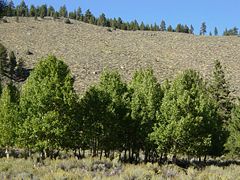Aspen
| Aspen | ||||||||||||||
|---|---|---|---|---|---|---|---|---|---|---|---|---|---|---|
 A Quaking Aspen grove
|
||||||||||||||
| Scientific classification | ||||||||||||||
|
||||||||||||||
| Species | ||||||||||||||
|
Populus adenopoda |
Aspens are trees of the willow family and comprise a section of the poplar genus, Populus sect. Populus. There are six species in the section, one of them atypical, and one hybrid:
- Populus adenopoda: Chinese Aspen (China, south of P. tremula)
- Populus sieboldii: Japanese Aspen (Japan)
- Populus alba: White Poplar (northwest Africa, southern Europe, east to central Asia)
- Populus × canescens: Grey Poplar (hybrid P. alba × P. tremula)
- Populus tremula: Common, Swedish, Trembling or Eurasian Aspen (northern Europe & Asia)
- Populus tremuloides: Quaking, Trembling or American Aspen (northern & western North America)
- Populus grandidentata: Bigtooth Aspen (eastern North America, south of P. tremuloides)
Contents |
Leaves
The Quaking Aspen of North America is known for its leaves turning spectacular tints of red and yellow in the autumn of the year (and usually in the early autumn at the altitudes where it lives). This causes forests of aspen trees to be noted tourist attractions for viewing them in the fall. These aspens are found as far south as the San Bernardino Mountains of Southern California, though they are most famous for growing in Colorado.
Aspens, apart from the aberrant White Poplar, are distinguished by their nearly round leaves on mature trees, 9–16 centimeters in diameter with irregular rounded teeth. They are carried on strongly flattened leaf stems, that cause the leaves to twist and flutter in slight breezes. The juvenile leaves on young seedlings and root sprouts differ markedly from the adult leaves, being nearly triangular, showing here the typical leaf shape of most other poplars; they are also often much larger, 13–26 cm long. The five typical aspens are distinguished from each other by leaf size and the size and spacing of the teeth on the adult leaves. White Poplar leaves differ in being deeply five-lobed, covered in thick white down, and having only a slightly flattened leaf stem.
Habitat and longevity
The five typical aspens are all native to cold regions with cool summers, in the north of the Northern Hemisphere, extending south at high altitudes in the mountains. The White Poplar, by contrast, is native to warmer regions, with hot, dry summers. These trees are all medium-sized deciduous trees ranging 15–30 meters tall.
All of the aspens (including the White Poplar) typically grow in large clonal colonies derived from a single seedling, and spreading by means of root suckers; new stems in the colony may appear at up to 30–40 meters from the parent tree. Each individual tree can live for 40–150 years above ground, but the root system of the colony is long-lived. In some cases, this is for thousands of years, sending up new trunks as the older trunks die off above ground. For this reason it is considered to be an indicator of ancient woodlands. One such colony in Utah, given the nickname of "Pando", is claimed to be 80,000 years old, making it possibly the oldest living colony of aspens. Some aspen colonies become very large with time, spreading about a meter per year, eventually covering many hectares. They are able to survive forest fires, since the roots are below the heat of the fire, with new sprouts growing after the fire burns out.
However, aspens do not thrive very well in the shade, and it is difficult for aspen seedlings to grow in an already mature aspen stand. Fire indirectly benefits aspen trees, since it allows the saplings to flourish in open sunlight in the burned landscape. Lately, aspens have an increased popularity in forestry, mostly because of their fast growth rate and ability to regenerate from sprouts, making the regeneration of the forest after harvesting much cheaper, since no planting or sowing is required.
In contrast with many trees, aspen bark is base-rich, meaning that aspens are important hosts for bryophytes[1] and act as food plants for the larvas of Lepidoptera species—see List of Lepidoptera that feed on poplars.
Quaking leaves
The unusual ability of the leaves of Populus to twist and bend due to the flattened petioles may not be fully understood. It is thought to help protect the trees from severe winds, perhaps by helping dissipate energy more uniformly throughout the canopy.[2] It is also thought to improve the rate of photosynthesis throughout the tree by reducing the exposure of the outer leaves to extreme sunlight (thus reducing photoinhibition) by presenting the leaves at an oblique angle to the sun throughout the day, while at the same time allowing more light through to the lower leaves which are generally overshaded. This would enable leaves throughout the tree to photosynthesize more efficiently.[3]
Uses
Basque shepherds in 19th and 20th-century America were said to carve texts and figures on aspens of the American Southwest to express their loneliness.
Aspen wood is white and soft, but fairly strong, and has low flammability. It has a number of uses, notably for making matches, where its low flammability makes it safer to use than most other woods. Shredded aspen wood is used for packing and stuffing, sometimes called excelsior (wood wool). It is also a popular animal bedding, since it lacks the phenols associated with pine and juniper, which are thought to cause respiratory ailments in some animals. Heat-treated aspen is a popular material for the interiors of a sauna. The Native Americans also used the white powder from the trees as a sunscreen (SPF 5).